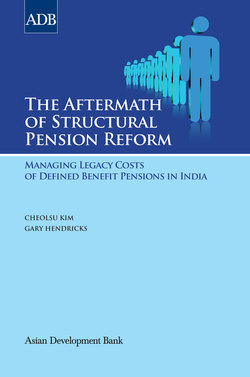Читать книгу The Aftermath of Structural Pension Reform - Cheolsu Kim - Страница 6
На сайте Литреса книга снята с продажи.
FOREWORD
ОглавлениеOn 1 January 2004, the Government of India embarked on the most important pension reform since its independence in 1947. It replaced the traditional defined benefit pension scheme with a new defined contributory scheme for central government employees. This unprecedented pension reform was driven mainly by the fiscal imperative to truncate the unfunded defined benefit civil service pension scheme that covers around 30 million central and state government employees.
Fiscal stress emanating from civil service retirement benefits was imposing an annual expenditure of over $30 billion on the central and state governments and had created an implicit pension debt—that is, the aggregate net present value of all pension payments due to government employees in the future—of over $600 billion, equivalent to 64% of India’s gross domestic product in 2006. The steep increase in states’ pension outlays was due mostly to the significant expansion in the number of state government employees, extension of pension coverage to employees of various nongovernment institutions, periodic increases in cost of living allowances, and improvements in life expectancy.
Almost all states were increasingly concerned about the sustainability and fiscal implications of their existing pension schemes and decided to adopt the New Pension Scheme. However, states still face sizable legacy costs for employees and pensioners covered under the old defined benefit scheme, although the magnitude and long-term impact of these costs remain unknown. Furthermore, almost all state governments lack the appropriate arrangements to collect and monitor data relating to current pensioners and future retirees. To quantify the financial impact on expenditure and savings from the reform accurately, state governments require good-quality demographic, income, and service data on their existing employees.
This book contains an account of the processes undertaken during, results achieved by, and the lessons learned from the efforts of five states—Assam, Bihar, Chhattisgarh, Jharkhand, and Madhya Pradesh—to estimate their current pension liabilities, to project annual pension costs over the next 15–25 years, and to explore options for managing their annual costs. These efforts benefited from technical assistance from the Asian Development Bank, which has supported and continues to support pension reform in Asia and the Pacific.
It is our hope that this book proves to be a valuable resource for policy makers, academics, and pension industry stakeholders, not only in India but also in other Asian Development Bank member countries, in instituting the same or similar pension reforms as those undertaken in the five states in India.
Sultan H. Rahman
Director General
South Asia Department
